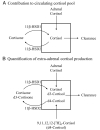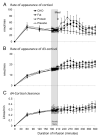The postprandial rise in plasma cortisol in men is mediated by macronutrient-specific stimulation of adrenal and extra-adrenal cortisol production
- PMID: 24092834
- PMCID: PMC4392802
- DOI: 10.1210/jc.2013-2307
The postprandial rise in plasma cortisol in men is mediated by macronutrient-specific stimulation of adrenal and extra-adrenal cortisol production
Abstract
Context: Circadian variation is a fundamental characteristic of plasma glucocorticoids, with a postprandial rise in cortisol an important feature. The diurnal rhythm is presumed to reflect alterations in hypothalamic-pituitary-adrenal axis activity; however, cortisol is produced not only by the adrenal glands but also by regeneration from cortisone by the enzyme 11β-hydroxysteroid dehydrogenase type 1, mainly in liver and adipose tissue.
Objective: We tested the contribution of peripheral cortisol regeneration to macronutrient-induced circadian variation of plasma cortisol in humans.
Design: This was a randomized, single-blinded, crossover study.
Setting: The study was conducted at a hospital research facility.
Participants: Eight normal-weight healthy men participated in the study.
Interventions: Subjects were given isocaloric energy isodense flavor-matched liquid meals composed of carbohydrate, protein, fat, or low-calorie placebo during infusion of the stable isotope tracer 9,11,12,12-[2H]4-cortisol.
Outcome measures and results: Plasma cortisol increased similarly after all macronutrient meals (by ∼90 nmol/L) compared with placebo. Carbohydrate stimulated adrenal secretion and extra-adrenal regeneration of cortisol to a similar degree. Protein and fat meals stimulated adrenal cortisol secretion to a greater degree than extra-adrenal cortisol regeneration. The increase in cortisol production by 11β-hydroxysteroid dehydrogenase type 1 was in proportion to the increase in insulin. The postprandial cortisol rise was not accounted for by decreased cortisol clearance.
Conclusions: Food-induced circadian variation in plasma cortisol is mediated by adrenal secretion and extra-adrenal regeneration of cortisol. Given that the latter has the more potent effect on tissue cortisol concentrations and that effects on adrenal and extra-adrenal cortisol production are macronutrient specific, this novel mechanism may contribute to the physiological interplay between insulin and glucocorticoids and the contrasting effects of certain diets on postprandial metabolism.
Figures



References
-
- Baggio LL, Drucker DJ. Biology of incretins: GLP-1 and GIP. Gastroenterology. 2007;132:2131–2157. - PubMed
-
- Macfarlane DP, Forbes S, Walker BR. Glucocorticoids and fatty acid metabolism in humans: fuelling fat redistribution in the metabolic syndrome. J Endocrinol. 2008;197:189–204. - PubMed
-
- Quigley ME, Yen SS. A mid-day surge in cortisol levels. J Clin Endocrinol Metab. 1979;49:945–947. - PubMed
-
- Follenius M, Brandenberger G, Hietter B. Diurnal cortisol peaks and their relationships to meals. J Clin Endocrinol Metab. 1982;55:757–761. - PubMed
-
- Slag MF, Ahmad M, Gannon MC, Nuttall FQ. Meal stimulation of cortisol secretion: a protein induced effect. Metabolism. 1981;30:1104–1108. - PubMed
Publication types
MeSH terms
Substances
Grants and funding
LinkOut - more resources
Full Text Sources
Other Literature Sources

